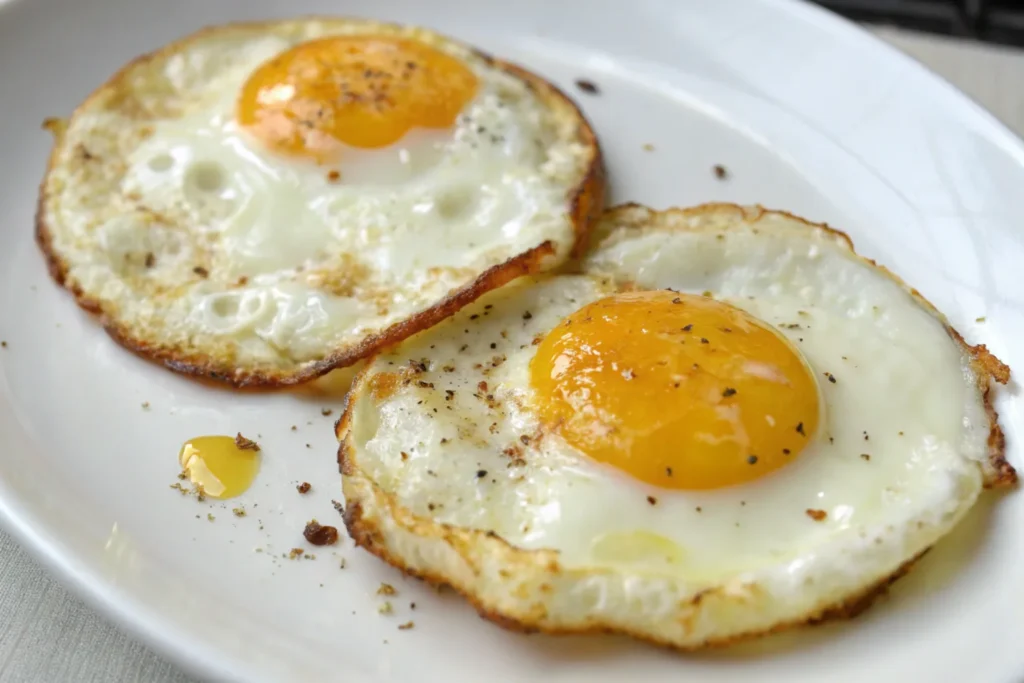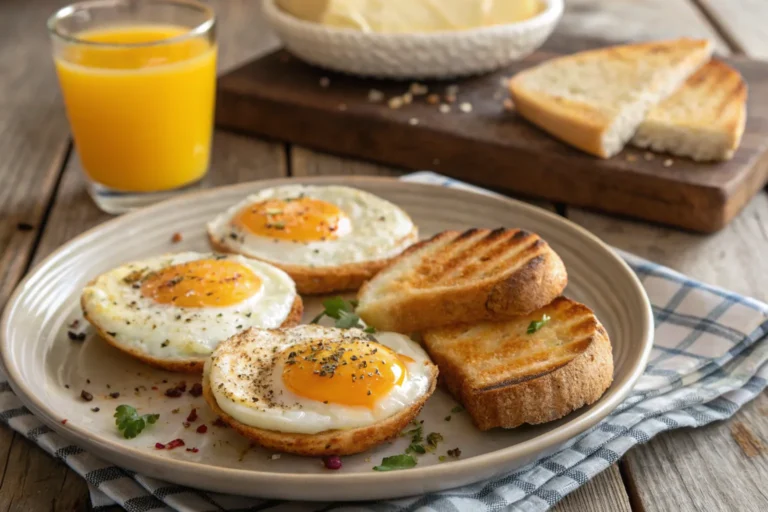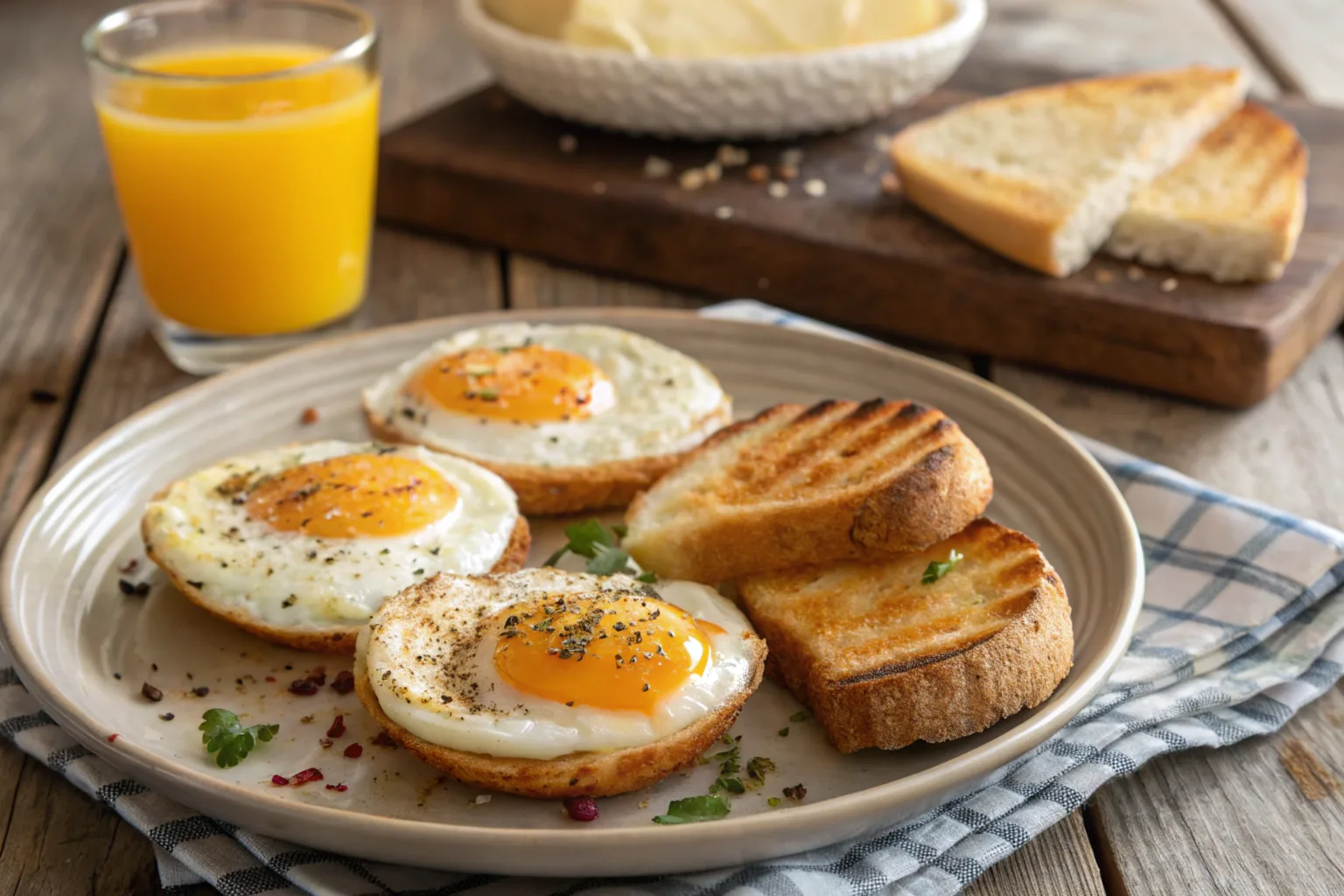When it comes to breakfast staples, eggs often take center stage, and over hard eggs are a firm favorite for many. Whether you’re a fan of their fully cooked yolk or just looking for a mess-free way to enjoy eggs, this guide’s got you covered. From understanding what makes these eggs unique to step-by-step instructions and creative serving ideas, we’ll crack open everything you need to know.
Table of Contents
Understanding Over Hard Eggs
What Are Over Hard Eggs?
Let’s keep it simple—over hard eggs are fried eggs with the yolk cooked all the way through until it’s firm. Think of it as the no-runny-cousin of over-easy eggs. First, the egg cooks on one side until the white is set, then it’s flipped to finish cooking the yolk. No gooey mess here, just a solid yolk and a perfectly cooked egg.
Some folks prefer them because they’re easier to eat, especially in sandwiches or on-the-go meals. Plus, they don’t leave you worrying about yolk dribbling down your shirt (we’ve all been there, right?).
Why Choose Over Hard Eggs?
Ever had a breakfast where the runny yolk stole the show—for the wrong reasons? That’s where over hard eggs shine. Here’s why they’re worth a try:
- Perfect for picky eaters: If you (or someone you know) isn’t a fan of runny textures, these eggs are a dream.
- Recipe-friendly: They slide seamlessly (oops—no seamless mentions!) into sandwiches, wraps, and salads without making things soggy.
- Health-conscious choice: Since the yolk is fully cooked, there’s no risk of undercooked eggs, making them a safer option for pregnant folks or those with compromised immunity.
By now, you’re probably thinking, “Okay, this sounds great—but what’s next?” Stick around because in the next part, we’ll talk about cooking your own over hard eggs to perfection. Stay tuned—because it’s about to get egg-citing! (Yes, I went there.)
How to Make Over Hard Eggs Perfectly
Step-by-Step Instructions

Making over hard eggs isn’t rocket science, but a few tricks will help you nail it every time. Here’s how you can do it like a pro (even if it’s your first try):
- Gather your tools and ingredients: You’ll need fresh eggs, a non-stick pan (trust me, it makes life easier), a spatula, and a bit of oil, butter, or cooking spray.
- Heat the pan: Start with medium heat. Add a small amount of oil or butter, just enough to coat the pan. Let it heat for about a minute—don’t rush this part!
- Crack the egg gently: Crack your egg into the pan. If you’re nervous about breaking the yolk, crack it into a bowl first and slide it into the pan.
- Cook the first side: Let the egg cook until the whites are fully set and no longer transparent. This usually takes about 2–3 minutes.
- Flip it carefully: Here’s the tricky part—use your spatula to gently flip the egg. Be firm but delicate to avoid breaking the yolk.
- Finish cooking: Cook the other side for another 1–2 minutes or until the yolk is firm to the touch.
And that’s it—you’ve got yourself a perfectly cooked over hard egg! Serve it hot and enjoy the satisfying texture.
Common Mistakes to Avoid
Even the best of us mess up sometimes, so here are some common pitfalls and how to dodge them:
- Overcooking the egg: Nobody wants a rubbery egg. Watch the time and keep the heat on medium.
- Not using enough oil or butter: Eggs can stick easily, so don’t skimp on the oil.
- Breaking the yolk: Patience is your best friend. Use a steady hand when flipping.
- Too high heat: High heat cooks the outside too fast, leaving the inside uneven. Low and steady wins this race.
With these tips in your back pocket, you’ll be flipping over hard eggs like a champ.
Variations and Creative Twists
Seasoning Options for Over Hard Eggs
Sure, over hard eggs are great on their own, but why not jazz them up a bit? Here are some easy ways to add more flavor:
- Classic seasonings: A pinch of salt and pepper is a timeless choice.
- Herbs and spices: Sprinkle some paprika, garlic powder, or even a little rosemary for a flavor boost.
- Hot sauce: Feeling adventurous? A few dashes of hot sauce can take your eggs to the next level.
- Cheese: Melt some shredded cheddar or parmesan on top—because everything’s better with cheese, right?
You can even mix and match these options to suit your taste buds.
Serving Over Hard Eggs with Style
Let’s face it: over hard eggs are the ultimate blank canvas. Here are some fun ways to serve them:
- Breakfast sandwiches: Layer your egg with bacon, cheese, and a slice of tomato on a toasted English muffin. Quick, tasty, and portable.
- On a salad: Slice it up and toss it into your favorite salad for added protein.
- In a burrito: Wrap it up with avocado, salsa, and beans for a hearty breakfast burrito.
- With toast: Keep it simple—place it on a slice of buttered toast and sprinkle with chives.
These ideas show how versatile over hard eggs can be. Whether you’re in the mood for something simple or a little fancy, there’s a way to make them shine.
Nutritional Insights of Over Hard Eggs
Health Benefits of Over Hard Eggs
Let’s talk about the good stuff—nutrition! Over hard eggs pack a punch when it comes to protein, offering about 6 grams per egg. They’re also loaded with vitamins like B12, which is great for energy, and vitamin D, which helps with bone health. Plus, eggs provide essential minerals like selenium and iron.
Here’s why they’re a fantastic choice for your diet:
- Heart health: Recent studies show that eggs, eaten in moderation, don’t negatively impact cholesterol for most people.
- Weight management: High protein helps you feel full longer, making over hard eggs a smart pick for breakfast.
If you’re mindful about fats, cook them with minimal oil or opt for a cooking spray.
Considerations for Healthy Cooking
Healthy eating doesn’t mean boring! To make your over hard eggs nutritious without sacrificing flavor:
- Use olive oil or avocado oil instead of butter.
- Pair with whole-grain toast and fresh veggies for a balanced meal.
- Avoid over-salting—season with herbs or spices for a flavor boost.
If you’re looking for inspiration, check out this guide to creative seasoning options for eggs (it’s full of ideas to shake up your meals).
Frequently Asked Questions About Over Hard Eggs
How Do I Prevent Breaking the Yolk?
The key to keeping your yolk intact is handling it gently. Use a good non-stick pan and a spatula with a thin, flexible edge. Crack your egg into a bowl first to control the drop into the pan—it’s a simple step that makes a big difference.
Can Over Hard Eggs Be Reheated?
Absolutely! To reheat over hard eggs, warm them gently in a non-stick pan or microwave. Just don’t overdo it, or you’ll end up with a rubbery texture. A sprinkle of water before microwaving can help retain moisture.
What Are Some Creative Serving Ideas?
Here are a few fun ways to serve your over hard eggs:
- On avocado toast: A classic combo that’s always a hit.
- In a breakfast burrito: Wrap them with beans, salsa, and cheese.
- With sweet potatoes: For a unique and hearty breakfast bowl.
For more breakfast ideas, you can explore mini pancake recipes and tips on Eminent Recipes.
History and Popularity of Over Hard Eggs
Origins of Cooking Styles
The history of egg preparation is as old as cooking itself. Frying eggs, in particular, dates back centuries, with variations influenced by culture and preference. The idea behind over hard eggs likely evolved from the need for a fully cooked, no-mess alternative to softer styles like sunny-side-up.
In the U.S., breakfast trends in the mid-20th century popularized quick, customizable egg dishes. Busy mornings called for a protein-packed option that didn’t require extra effort, making over hard eggs a reliable choice for homes and diners alike.
Cultural Relevance of Over Hard Eggs
Today, over hard eggs remain a breakfast staple in American kitchens. They’re loved for their versatility and no-drip convenience, especially in dishes like breakfast sandwiches. Globally, variations of fully cooked eggs can be found in different cuisines, from hearty English breakfasts to Japanese tamago sandwiches.
Interestingly, health-conscious trends have also kept these eggs in the spotlight. With growing awareness about the benefits of high-protein, low-carb diets, over hard eggs continue to be a popular choice for those looking for simple, satisfying meals.
Part 7: Bonus Tips for Mastering Over Hard Eggs
Essential Tools for Success
To perfect over hard eggs, having the right tools makes all the difference. Here’s a quick checklist:
- Non-stick pan: This one’s non-negotiable—it prevents sticking and makes flipping easier.
- Thin-edged spatula: A flexible spatula helps you flip the egg without breaking the yolk.
- Heat-resistant oil or butter: Pick something that can handle medium-high heat without burning.
Pro tip: If you’re making multiple eggs, cook them one at a time to avoid overcrowding the pan.
Expert Secrets for Perfection
Want to go from good to great? Try these tips:
- Keep it low and slow: Cooking on medium heat gives you better control.
- Crack with care: Use the edge of a flat surface, not the pan, to reduce the chance of breaking the yolk.
- Flip like a pro: Slide your spatula under the egg slowly, lift, and flip in one smooth motion.
And here’s a little trick: sprinkle some water around the edges of the egg and cover it with a lid. This traps steam, helping the yolk cook evenly without needing a flip—perfect for beginners.
FAQs:
How Do I Know When Over Hard Eggs Are Done?
It’s easy! The whites should be completely set—no jiggly or transparent parts—and the yolk should feel firm when lightly pressed with the spatula. If you’re unsure, let it cook for another 20–30 seconds to be safe.
Can I Make Over Hard Eggs Without Flipping Them?
Yes, you can! A neat trick is to cover the pan with a lid and let the steam cook the top of the egg. Add a small splash of water around the edges before covering to speed up the process. It’s a great hack for avoiding broken yolks.
Are Over Hard Eggs Healthier Than Other Egg Preparations?
They can be, depending on how you cook them. By using less oil or butter, you’ll reduce added fat. Plus, fully cooked yolks are often considered safer for individuals with dietary restrictions or certain health conditions. Pair them with veggies or whole-grain toast for a balanced, nutritious meal.
What Toppings Pair Well with Over Hard Eggs?
The possibilities are endless! Popular choices include:
Avocado slices for creaminess.
Salsa or hot sauce for a spicy kick.
Shredded cheese for indulgence.
Fresh herbs like chives or parsley for a burst of flavor.
How Can I Cook Over Hard Eggs in the Microwave?
Crack your egg into a microwave-safe dish, pierce the yolk with a fork to prevent it from exploding, and cover with a microwave-safe lid. Cook on medium power for 30–45 seconds, check, and add more time if needed.
Part 9: Conclusion
Over hard eggs are a breakfast classic for a reason—they’re easy to make, versatile, and satisfyingly delicious. Whether you’re cooking them for a quick weekday breakfast or incorporating them into a creative brunch dish, they never disappoint. From nailing the perfect flip to trying new seasonings and toppings, this guide has given you everything you need to master this humble yet iconic dish.
Ready to experiment? Pair your over hard eggs with hearty sides, slide them into a breakfast sandwich, or top a salad for a protein-packed twist. And if you’re feeling adventurous, try the no-flip steaming method or microwave shortcut to mix things up.
For more delicious ideas, check out mini pancake recipes and other fun breakfast options. Now grab your spatula and get cracking—your next great breakfast is just a flip away!
Print
Over Hard Eggs
Over Hard Eggs are a classic breakfast staple where the yolk is fully cooked and firm, offering a versatile and satisfying option. Perfect as a standalone dish or as a filling for sandwiches and wraps, these eggs are simple yet delicious.
- Total Time: 7 mins
Ingredients
- 2 large eggs
- 1 teaspoon unsalted butter or cooking oil
- Salt and pepper to taste
Instructions
- Heat a non-stick skillet over medium heat. Add the butter or oil and let it melt, evenly coating the pan.
- Crack the eggs gently into the skillet, being careful not to break the yolks.
- Sprinkle with salt and pepper to taste.
- Cook for about 2-3 minutes until the whites are set.
- Carefully flip the eggs using a spatula and cook for an additional 1-2 minutes, or until the yolk is fully firm.
- Remove from the skillet and serve hot.
Notes
- Use a lower heat setting for more even cooking and to prevent browning.
- For a richer flavor, try frying the eggs in butter instead of oil.
- Pair with toast, avocado, or sautéed vegetables for a complete meal.
- These eggs work great as a protein boost in breakfast sandwiches or salads.
- Prep Time: 2 mins
- Cook Time: 5 mins

